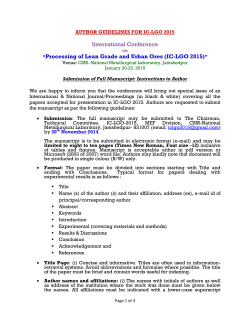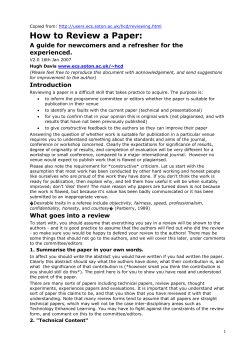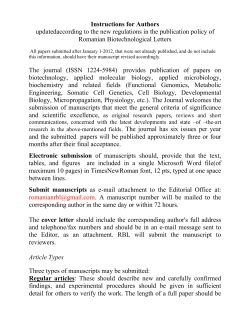
african journal of technical education and
AFRICAN JOURNAL OF TECHNICAL EDUCATION AND MANAGEMENT (AJTEM) MANUSCRIPTS GUIDELINES FOR AUTHORS Papers submitted for publication are expected to meet the following guidelines. Papers submitted will be peer-reviewed and might be recommended for publication. 1. Author(s)' responsibilities 1.1. Paper must be presented in English. 1.2. Paper must be of a standard acceptable for publication. 1.3. Work presented should not have been previously used in part or whole for another publication on another platform. 2. Submission of Articles 2.1 Soft copy: Articles should be submitted as an attachment via e-mail to: ajtem@hopoly.edu.gh and should comply with the following: 2.1.1 File formats: The preferred softcopies format for new submissions and re-submission of revised manuscript is PDF format. Please submit only the final version of your file (with no hidden text). 2.1.2 Graphics: All figures should be embedded and correctly positioned within your PDF in JPEG or GIF format. Scanned Art work, both line and half-tone photographs should be scanned at minimum settings of 300 dpi for half-tones and 800 dpi for line art. Compressed files should be in WinRAR. 2.1.3 File naming: To protect their anonymity in the review process, AUTHORS SHOULD NOT IDENTIFY THEMSELVES ON THE FRONT PAGE OR IN ANY HEADERS OR WHILE SAVING THE NAMES OF THEIR FILES. A SEPARATE TITLE PAGE MUST BE SENT AS AN ATTACHMENT TO THE EDITORS via the EMAIL ADDRESS ABOVE. 2.1.4 Title page: The title page should contain (i) the title of the paper, (ii) the full names of the author(s) and (iii) the addresses of the institutions at which the work was carried out together with (iv) the full postal and email address, Fax and telephone numbers, of the corresponding author. The present address of any author, if different from that where the work was carried out, should be supplied. A short running title (less than 40 characters) should also be provided. 1|Page 3. Typesetting 3.1 Articles should be typeset as follows: i. ii. iii. iv. Paper size: A4. Margins: Left 2.5 cm, Right 2.0 cm; Top: 2.0 cm Bottom 2.0 cm (For both text, tables and figures). Paper orientation: Portraits (except for broader tables or figures with captions only) Font: o Heading: (Type) Times New Roman, Size 14, bold, Capitalize Each Word except prepositions o Sub – heading: (Type) Times New Roman, Size 12, bold, Capitalize Each Word except prepositions o Sub sub-heading: (Type) Times New Roman, Size 12, italics, Capitalize Each Word except prepositions o Text: (Type) Times New Roman, Size 11, normal. o Line spacing: 1.5 spacing. o Indent: flush left o Table and Figure captions: (Type) Times New Roman, Size 11, bold, Capitalize Each Word except prepositions 3.2 Insert one line space between paragraphs, and two line spaces between paper title, and Abstract. 3.3 The title of the paper, abstract and keywords should be set out following the notes in section 4 below. 3.4 The maximum acceptable length of an article is 5000 words (less 250 words for each normal-sized figure or table you include): please do NOT exceed this limit or your paper will be rejected. 4. Content Papers should be well structured: i.e. they must comprise: 4.1 Title: The title should be short (25 words maximum), informative and contain the major key words. Do not use abbreviations in the title. 4.2 Abstract: Not more than 150 words briefly specifying the aims of the work, the main results obtained, and the conclusions drawn. 4.3 Keywords: 3–6 keywords (in alphabetical order) which will enable subsequent abstracting or information retrieval systems to locate the paper. 2|Page 4.4 Main text: For clarity, this should be sub-divided into: (i) Introduction - describing the background of the work and its aims. (ii) Methods - a brief description of the methods/techniques used (the principles of these methods should not be described if readers can be directed to easily accessible references or standard texts). (iii) Results and Discussion - a clear presentation of experimental results obtained, highlighting any trends or points of interest. (iv) Conclusions: a brief explanation of the significance and implications of the work reported. NB: Do not number or letter section headings. 4.5 References: these should be made to accessible sources. Please ensure that all works cited in the text are included in the reference list, and that the dates and authors given in the text match those in the reference list. References must always be given in sufficient detail for the reader to locate the works cited (refer to section 7 below for formats). 5. Nomenclature/Units 5.1 Please ensure that all terminologies and notations used are widely understood. Avoid author-invented acronyms and abbreviations. Abbreviations and acronyms should be written-out in full at their first occurrence in the text (note that where an abbreviation has been written-out in full in the abstract, it must still be written-out in full in the text the first time it is used). Abbreviate units of measure when used with numerals (50ml; 1000kg). Chemical formulae should be written out unless they are used to economise space in the column headings of a table, however, the formulae should be expanded in the footnotes. 5.2 SI units should be used in all cases. If non-SI units must be used, SI equivalents (or conversion factors) must also be given. Please use the spellings “litre” and “metre” (a “meter” is a measuring instrument). 5.3 Please use a decimal point rather than a comma in numbers (i.e. 3.142 not 3,142). 5.4 Write equations in dimensionless form or in metric units. Please use italics to denote variables (in text or in displayed equations). 6. Figures and Tables 6.1 Figures and tables should appear in numerical order, be described in the body of the text and be positioned close to where they are first cited. 3|Page 6.2 Make sure all figures and tables fit inside the text area. 6.3 Because figures may be re-sized in the course of production please use scale bars and not magnification factors. 6.4 Art work should be drawn and lettered for finished size and subsequent reduction to 75% using a Times New Roman (type). Giving a final size after reduction of 8 point (type) with appropriate line weights. 6.5 Table captions should be at the top of tables while Figures are labelled below the diagrams. 6.6 Tables should be displayed in APA format 6.7 All illustrations (line drawings and photographs) are classified as figures. Provide all figures in black and white (monochrome colours). 7. References: citations in text 7.1 Use surname of author and year of publication: Jones (2002) or (Jones, 2002). 7.2 Insert initials only if there are two different authors with the same surname and same year of publication. 7.3 Two or more years in parentheses following an author's name are cited in ascending order of year, and two or more references published in the same year by the same author are differentiated by letters a, b, c, etc. For example: Brown (1999, 2002, 2003a, b). 7.4 Different references cited together should be in date order, for example: (Smith, 1959; Thomson and Jones, 1992; Green, 1999). 7.5 If a paper has been accepted for publication but has not been published the term "(in press)" should be used instead of a date. 7.6 If a paper has been submitted but not definitely accepted the term "(submitted)" should be used. If the paper is still being prepared the term "(in preparation)" should be used. 7.7 The abbreviation "et al.," should be used in the text when there are more than two coauthors of a cited paper. 8. List of References 8.1 References should be listed alphabetically at the end of the paper. Although "et al." is preferable in the text, in the list of references all authors should be given. 4|Page 8.2 Journal Reference Style: Behn, R. D. (2003). "Why Measure Performance? Different Purposes Require Different Measures". Public Administration Review. 63(5), 586-606. Zeng R. J., Lemaire R., Yuan Z. and Keller J. (2004). “A novel wastewater treatment process: simultaneous nitrification, denitrification and phosphorus removal”. Water Science and Technology, 50(10), 163-170. Note the order: Name of author(s). (year of publication). “Title of article”. Name of Journal. Volume (Issue number), first page-last page of article. 8.3 Book Reference Styles: Bell J. (2002). Treatment of Dye Wastewaters in the Anaerobic Baffled Reactor and Characterisation of the Associated Microbial Populations. PhD thesis, Pollution Research Group, Durban, University of Natal. Henze M., Harremoës P., LaCour Jansen J. and Arvin E. (1995). Wastewater Treatment: Biological and Chemical Processes. Heidelberg, Springer. McInerney M. J. (1999). Anaerobic metabolism and its regulation. In: Biotechnology, J. Winter (ed.), 2nd edn, Weinheim, Wiley-VCH Verlag, pp. 455-478. Sobsey M. D. and Pfaender F. K. (2002). Evaluation of the H2S method for Detection of Faecal Contamination of Drinking Water, Report WHO/SDE/WSH/02.08, Water Sanitation and Health Programme, Geneva, WHO. Standard Methods for the Examination of Water and Wastewater (1998). 20th Edn., Washington DC, American Public Health Association/American Water Works Association/Water Environment Federation. 8.4 Online references: these should specify the full URL for the reference and give the date on which it was consulted or accessed. Alcock S. J. and Branston L. (2000) SENSPOL: Sensors for Monitoring Water Pollution from Contaminated Land, Landfills and Sediment. http://www.cranfield.ac.uk/biotech/senspol/ (Accessed: 22 July 2005) 8.5 References in languages other than English should be accompanied by an English translation of the article title Barjenbruch M., Erler C and Steinke M. (2003) Untersuchungen an Abwasserteichanlagen in Sachsen-Anhalt im Jahr 2003 (Investigation on wastewater 5|Page lagoons in Saxony-Anhalt in 2003), Report for the Environment Ministry of Saxony-Anhalt, Magdeburg, Germany. 9. SOFTWARE CITATION Authors should cite Software developers in parenthesis in the text after the first mention of a software package. Software citations should include the name, version number and release date of the software as well as the name of the software developer. Example: “The data was analysed using the STATA statistical software (STATA version 13.1, 2013, StataCorp LP)”. 10. FOOTNOTES Footnotes should only be used if absolutely essential. Generally, incorporate all material in normal text. If used, footnotes should be brief and numbered consecutively in plain superscripts. Exceptions are (a) initial footnotes associated with the title of the article or author’s name, denoted by other symbols apart from asterisk. FOOTNOTES TO A TABLE Use lower case English letters to attach footnotes to specific items within the table, and place the footnotes below the bottom line of the table in (un-indented) paragraph form. For general explanatory notes, use the heading “Note:” and continue on the same line with the first word of the note, in paragraph form. Reserve the use of asterisk (e.g., *, ** or ***) to denote statistical significance levels. For example, "Asterisk (*) and double asterisk (**) denote variables significant at 10% and 5% respectively." 11. PERSONAL PRONOUNS USAGE Use of the personal pronouns “I”, “Our”, “We” should be used sparingly. 12. REVIEW PROCESS Submission of an article to AJTEM implies that the research described has not been published previously (except in the form of an abstract or an academic dissertation, thesis or research project). The covering letter should explicitly state that the manuscript is not under consideration for publication elsewhere. It is important that all authors approve the submission of the manuscript for consideration for publication. To verify originality, all manuscripts submitted to AJTEM will be checked using originality detection software. Following, every manuscript submitted to AJTEM shall undergo double blind review. Three reviewers shall be assigned to review the manuscript and responses from at least two reviewers and the Editor’s review of the paper shall be used to make a decision to accept the paper or not. 13. COPYRIGHT TRANSFER Ho Polytechnic (the publisher) holds the copyright on all materials published in the Journal or on the Journal’s website. All authors automatically transfer their article’s copyright to Ho Polytechnic when the manuscript is accepted for publication. If a manuscript is not accepted or is withdrawn before publication, transfer of copyright is null and void. 6|Page 14. CONFLICT OF INTEREST The Merriam-Webster online dictionary defines “Conflict of Interest” as a conflict between the private interests and the official responsibilities of a person in a position of trust. Authors must indicate whether there is a conflict of interest when lodging their submission via the email address. If there is a conflict of interest, the author (s) must clearly identify the conflict in a covering letter that declares any grants or other sources of funding that support reported research, as well as any relevant industrial links or affiliations that the author may have. Any potential conflicts of interest will be held in confidence while the paper is under review and will not influence the editorial decision but, if the article is accepted for publication, the Editor will consider whether such information needs to be communicated to the reader. 15. FUNDING/SUPPORT DISCLOSURE All financial and material support for the research and the work should be clearly and completely identified and submitted as a separate attachment with the manuscript. If there is no funding or support, a page should be attached stating such. 16. ETHICS POLICY For all submitted manuscripts involving human participants’ research conducted by one or more of the authors, the authors must communicate the following to the editors before the manuscript can be reviewed. (1) The authors have obtained approval from all appropriate Institutional Review Boards or equivalent institutional oversight authorities and (2) the data collection efforts do not involve deception of human subjects even if the protocol was approved by all appropriate Institutional Review Boards. If authors are uncertain whether their data collection procedure involved deception, please contact one of the editors. 17. ACKNOWLEDGEMENTS Authors are encouraged to acknowledge persons other than co-authors who have made essential contributions to the development of their study or manuscript. Permission from all persons named in acknowledgements must be obtained prior to submission to the Journal and authors must inform the editors in writing that such permission has been obtained. 18. PLAGIARISM The Merriam-Webster online dictionary defines plagiarism as “the act of using another person's words or ideas without giving credit to that person.” Authors are responsible for ensuring appropriate acknowledgement of copyrighted materials. In instances where plagiarism is suspected in a manuscript or published paper, the Editors in consultation with the Editorial Advisory Board will take appropriate steps to resolve the issue. 19. EDITORIAL PROCESSING & PRODUCTION Authors are to note that the editing process is separate from and starts after the peer-review process. Accepted manuscripts are edited to conform to the Journal’s style and space limitations. The corresponding author will receive an electronic proof of the article and 7|Page have an opportunity to review editorial changes and to double-check accuracy of content, tables and statistics before publication. Galley proofs should be reviewed by the corresponding author or his representative within 5 business days of receipt. 20. ARTICLE IN PRESS The Journal does not permit un-authorised pre-publication of any material accepted and due for publication. “Articles in press” will be posted on the Journal’s website by the editors. 21. REGULAR PUBLICATION RATES Local - GHS100 Overseas - USD50 22. EDITORIAL CORRESPONDENCE The Managing Editor African Journal of Technical Education and Management Ho Polytechnic P. O. Box HP 217 Ho Tel: +233 209374860 Email: ajtem@hopoly.edu.gh 23. SUBSCRIPTION INFORMATION The Editor-In-Chief African Journal of Technical Education and Management Ho Polytechnic P. O. Box HP 217 Ho Tel: +233 268401861 Email: ajtemeic@hopoly.edu.gh 24. SUBSCRIPTION RATES (HARD COPY) Local -GHS50 Overseas i. ii. 8|Page Individuals Libraries & Institutions -USD 20 -USD 40
© Copyright 2025












